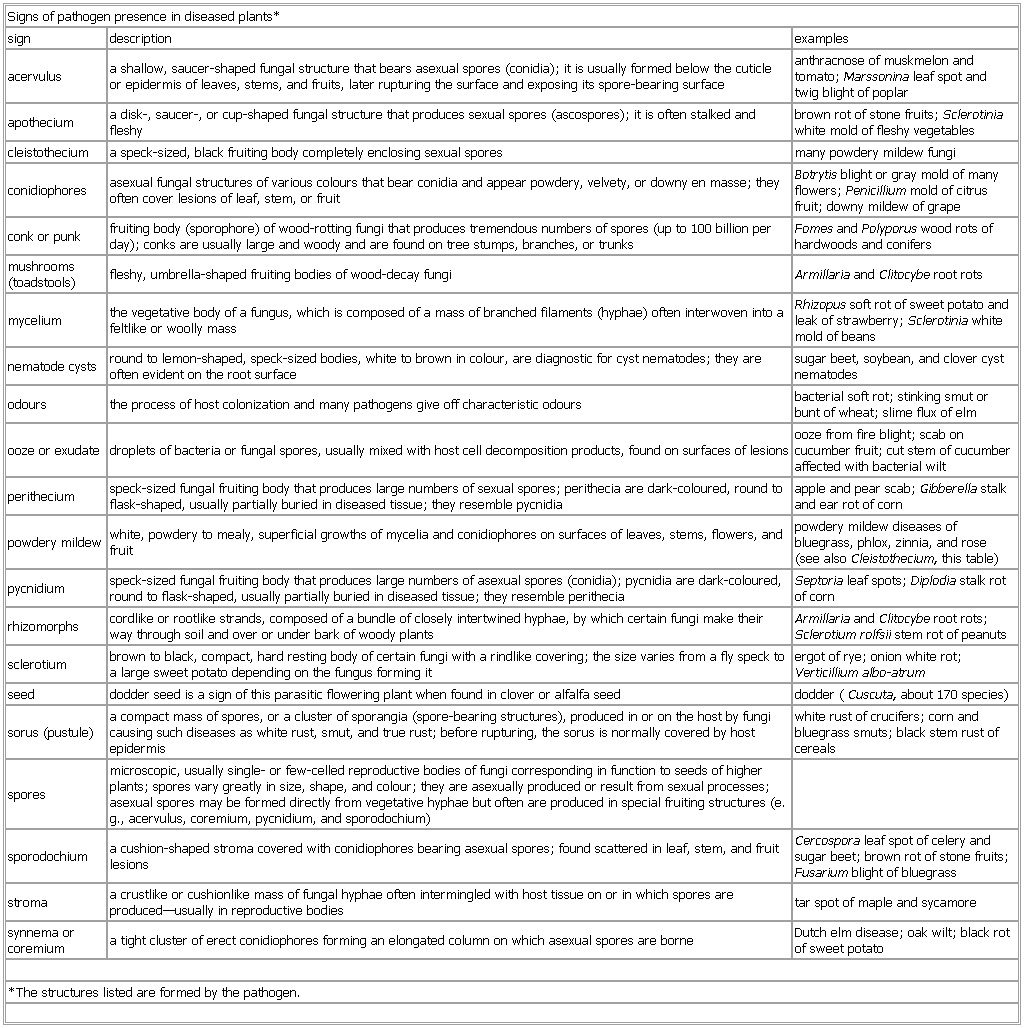- Signs of pathogen presence in diseased plants
-
▪ TableSigns of pathogen presence in diseased plants*sign description examplesacervulus a shallow, saucer-shaped fungal structure that bears asexual spores (conidia); it is usually formed below the cuticle or epidermis of leaves, stems, and fruits, later rupturing the surface and exposing its spore-bearing surface anthracnose of muskmelon and tomato; Marssonina leaf spot and twig blight of poplarapothecium a disk-, saucer-, or cup-shaped fungal structure that produces sexual spores (ascospores); it is often stalked and fleshy brown rot of stone fruits; Sclerotinia white mold of fleshy vegetablescleistothecium a speck-sized, black fruiting body completely enclosing sexual spores many powdery mildew fungiconidiophores asexual fungal structures of various colours that bear conidia and appear powdery, velvety, or downy en masse; they often cover lesions of leaf, stem, or fruit Botrytis blight or gray mold of many flowers; Penicillium mold of citrus fruit; downy mildew of grapeconk or punk fruiting body (sporophore) of wood-rotting fungi that produces tremendous numbers of spores (up to 100 billion per day); conks are usually large and woody and are found on tree stumps, branches, or trunks Fomes and Polyporus wood rots of hardwoods and conifersmushrooms (toadstools) fleshy, umbrella-shaped fruiting bodies of wood-decay fungi Armillaria and Clitocybe root rotsmycelium the vegetative body of a fungus, which is composed of a mass of branched filaments (hyphae) often interwoven into a feltlike or woolly mass Rhizopus soft rot of sweet potato and leak of strawberry; Sclerotinia white mold of beansnematode cysts round to lemon-shaped, speck-sized bodies, white to brown in colour, are diagnostic for cyst nematodes; they are often evident on the root surface sugar beet, soybean, and clover cyst nematodesodours the process of host colonization and many pathogens give off characteristic odours bacterial soft rot; stinking smut or bunt of wheat; slime flux of elmooze or exudate droplets of bacteria or fungal spores, usually mixed with host cell decomposition products, found on surfaces of lesions ooze from fire blight; scab on cucumber fruit; cut stem of cucumber affected with bacterial wiltperithecium speck-sized fungal fruiting body that produces large numbers of sexual spores; perithecia are dark-coloured, round to flask-shaped, usually partially buried in diseased tissue; they resemble pycnidia apple and pear scab; Gibberella stalk and ear rot of cornpowdery mildew white, powdery to mealy, superficial growths of mycelia and conidiophores on surfaces of leaves, stems, flowers, and fruit powdery mildew diseases of bluegrass, phlox, zinnia, and rose (see also Cleistothecium, this table)pycnidium speck-sized fungal fruiting body that produces large numbers of asexual spores (conidia); pycnidia are dark-coloured, round to flask-shaped, usually partially buried in diseased tissue; they resemble perithecia Septoria leaf spots; Diplodia stalk rot of cornrhizomorphs cordlike or rootlike strands, composed of a bundle of closely intertwined hyphae, by which certain fungi make their way through soil and over or under bark of woody plants Armillaria and Clitocybe root rots; Sclerotium rolfsii stem rot of peanutssclerotium brown to black, compact, hard resting body of certain fungi with a rindlike covering; the size varies from a fly speck to a large sweet potato depending on the fungus forming it ergot of rye; onion white rot; Verticillium albo-atrumseed dodder seed is a sign of this parasitic flowering plant when found in clover or alfalfa seed dodder (Cuscuta, about 170 species)sorus (pustule) a compact mass of spores, or a cluster of sporangia (spore-bearing structures), produced in or on the host by fungi causing such diseases as white rust, smut, and true rust; before rupturing, the sorus is normally covered by host epidermis white rust of crucifers; corn and bluegrass smuts; black stem rust of cerealsspores microscopic, usually single- or few-celled reproductive bodies of fungi corresponding in function to seeds of higher plants; spores vary greatly in size, shape, and colour; they are asexually produced or result from sexual processes; asexual spores may be formed directly from vegetative hyphae but often are produced in special fruiting structures (e.g., acervulus, coremium, pycnidium, and sporodochium)sporodochium a cushion-shaped stroma covered with conidiophores bearing asexual spores; found scattered in leaf, stem, and fruit lesions Cercospora leaf spot of celery and sugar beet; brown rot of stone fruits; Fusarium blight of bluegrassstroma a crustlike or cushionlike mass of fungal hyphae often intermingled with host tissue on or in which spores are produced—usually in reproductive bodies tar spot of maple and sycamoresynnema or coremium a tight cluster of erect conidiophores forming an elongated column on which asexual spores are borne Dutch elm disease; oak wilt; black rot of sweet potato*The structures listed are formed by the pathogen.See as table:

* * *
Universalium. 2010.
